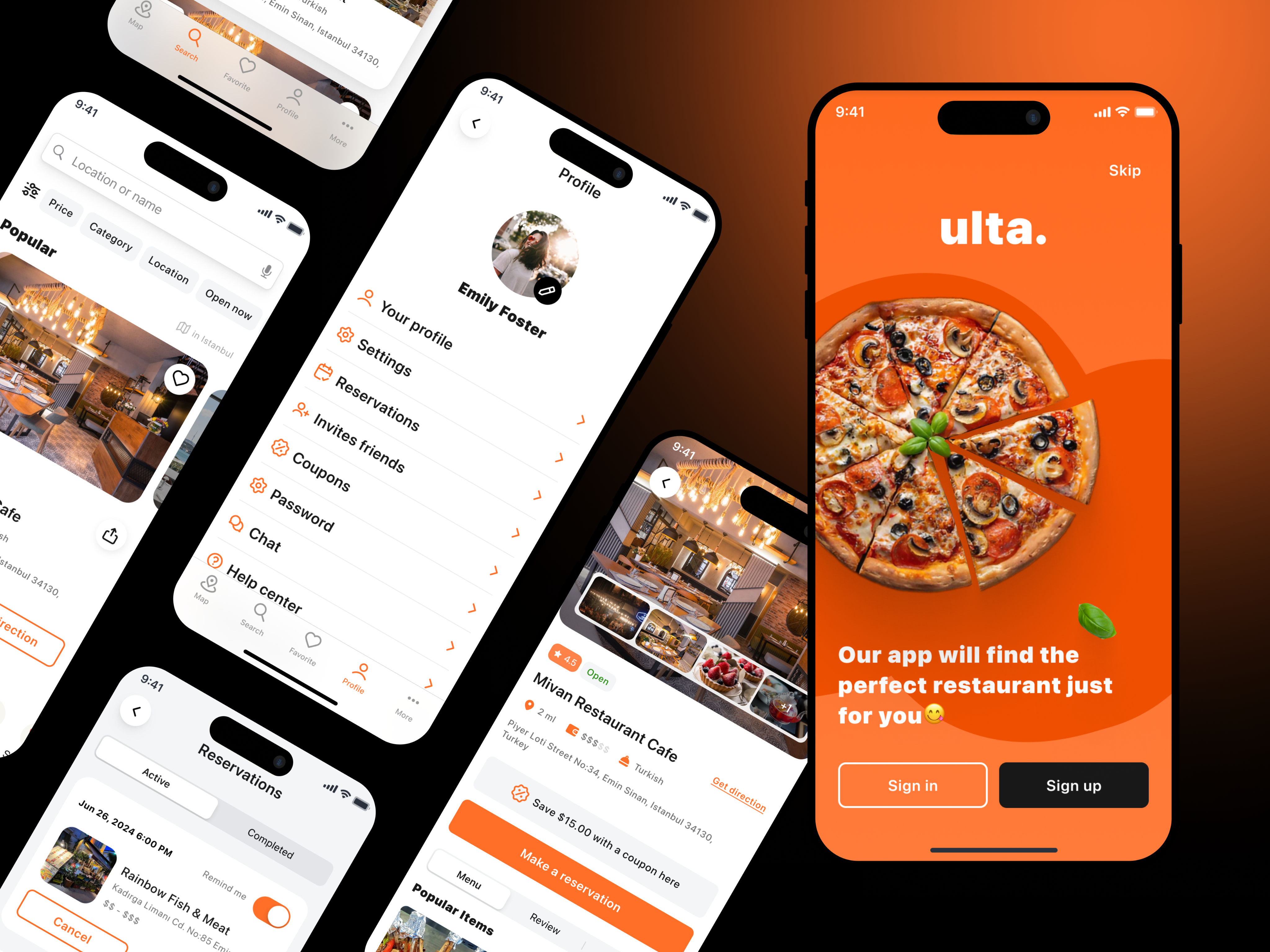Olga Kusterer
Main page
→
Resume
→
Restaurant guide app
Mobile and Cross-Platform Application Design.


Mobile and Cross-Platform Application Design. This educational project from Yandex was designed for experienced designers, focusing on the step-by-step creation of an app interface from scratch. Before starting the design process, I conducted extensive research on the topic and the product and carried out in-depth interviews with potential users. I was the top student in the course, and the testing of the prototype received positive feedback. About school.
AI-Powered App to Discover Your Favorite or New Dining Spot!
Project Objective
🧭 Problem
People lack a trustworthy and personalized way to discover restaurants and cafes they’ll truly enjoy—especially when traveling. Existing apps overwhelm users with options that don't reflect their unique tastes. Reviews are often unreliable or AI-generated. Word-of-mouth from friends is limited and time-consuming. Influencer and print guides also lack trust and personalization. Modern diners need a smarter, faster solution.
🚀 Solution
ULTA is a curated restaurant guide designed for modern lifestyles. The app offers fast, intelligent search tailored to real needs—like dog-friendly spots, places to work from, or venues with live music. AI personalization considers ambiance, style, and even noise level. Intuitive filters are crafted with a modern user in mind, making decisions faster and more relevant than ever before.
🎯 Audience & Focus
ULTA is designed for curious urban diners aged 20–40 with above-average income who enjoy spending time in cafes and restaurants. Many live in big cities or travel frequently and need quick access to reliable, personalized options. Initial launch focuses on key cultural hubs: Istanbul, Amsterdam, Tallinn, and Paris—each with a vibrant, dynamic food scene.
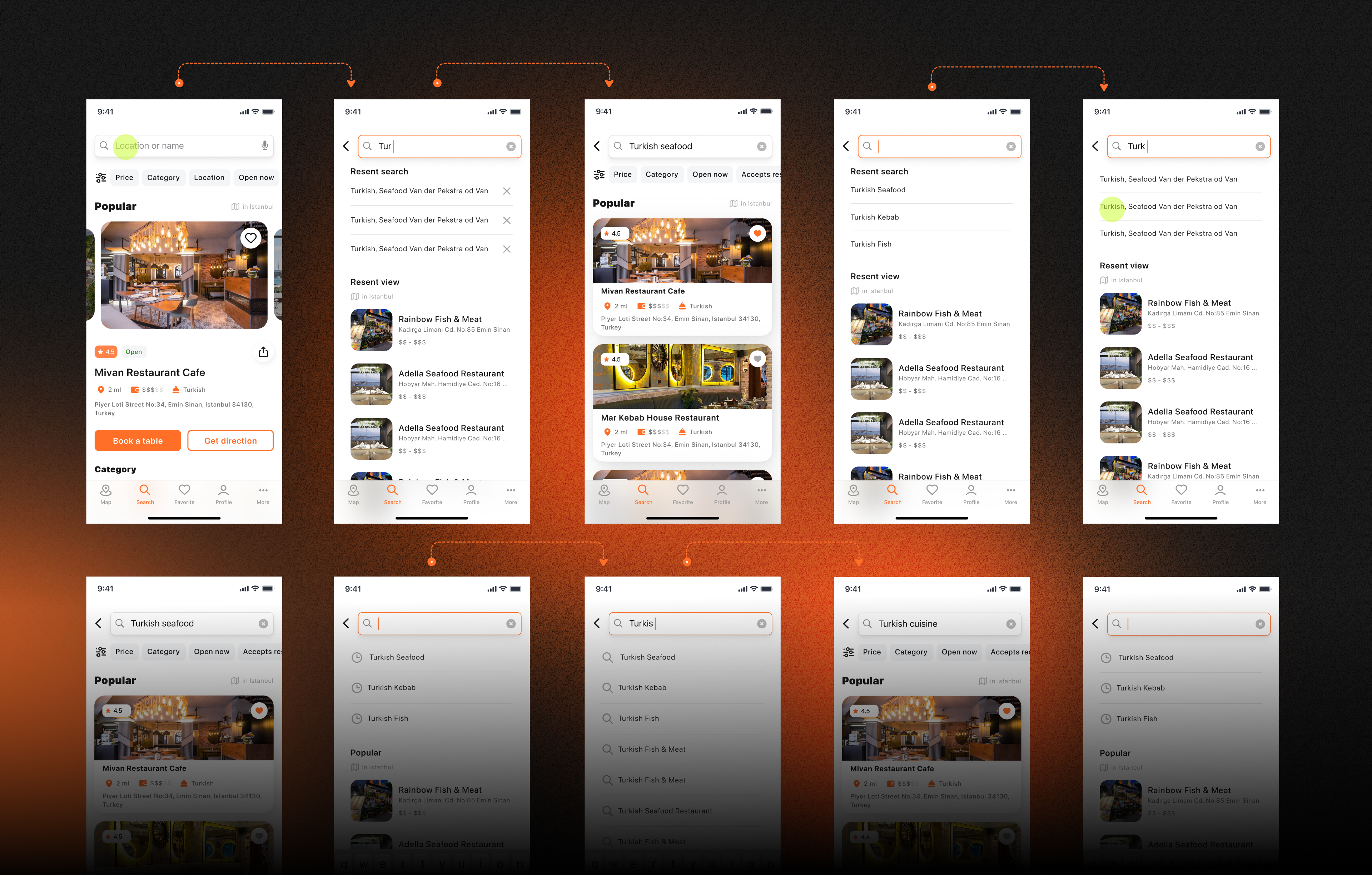
Secondary Research
Target Diners Aged 20-40.
Through secondary research, I discovered that although tastes and preferences vary based on several factors, Ulta should be optimized for diners aged 20-40. I also concluded that Ulta should not allow users to register with their phone number. Ulta’s target audience is more likely to travel abroad, implying that they may not have a consistent phone number while using the app. Instead, users should be encouraged to register with an email address. Also, chat support can be implemented via WhatsApp or in-app messaging as these services can be accessed using Wi-Fi. Finally, I acquired data from AppFlow, which allowed me to analyze competitor features, user feedback, and technical issues. This research can be found via this link.
Secondary research helped me formulate key hypotheses before conducting in-depth interviews.
Information about cities in numbers
around 15-20 million restaurants in the world /2020
around 1,500 to 2,000 restaurants and eateries in Amsterdam
Paris is home to approximately 15,000 to 20,000 restaurants
Tallinn is estimated to have around 500 to 700 restaurants
Istanbul typically attracts around 10 to 15 million tourists /2024
Istanbul is estimated to have approximately 25,000 to 30,000 restaurants
Amsterdam typically attracts around 8 to 10 million tourists /2024
Paris typically sees approximately 30 to 35 million tourists /2024
Tallinn attracts approximately 1.5 to 2 million tourists annually /2024
In-Depth Interviews
Women
31-64 YEARS OLD

Men
33-64 YEARS OLD

Task
Ask how respondents search for leisure activities or events and identify key features or functions of the app that they use every time.
SAMPLE
User Flow:6 respondents (4 women and 2 men) with an even age distribution (31-62 years old). For the educational project, 6 respondents were sufficient. All of them actively use apps to find and plan leisure activities or enjoy dining at restaurants. They are potential users.
Method
Personal interaction. I asked which apps people use, what their favorite features in apps are, and what is important for them to see or what influences their choice of a particular place.
Summary of Hypotheses
not confirmed
partially confirmed
confirmed
new future
Each hypothesis is accompanied by user avatars, indicating who participated in either testing or validation. This helps ensure the quality of research findings.
User Flow - Main scenario
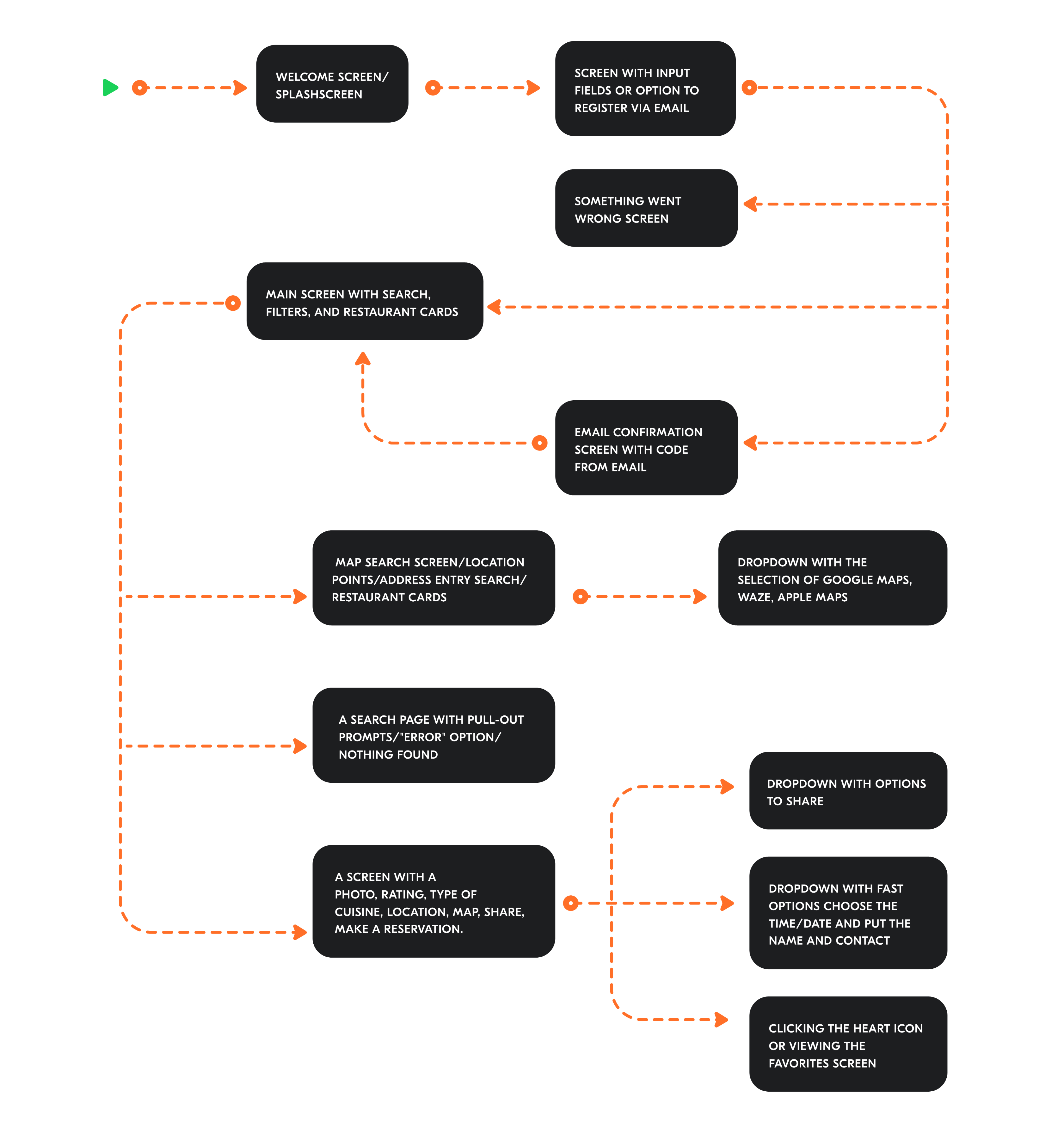
🌍 Seamless International Access
Email-based login ensures users maintain consistent access to their account while moving between countries.
🍽️ Designed for Real Travel Needs
This decision supports the app’s core goal — helping users find great places to eat while traveling, without connection barriers.
💬 Reliable Support Anywhere
Support is available via WhatsApp and in-app messaging, even without a local phone number.
Wireframe
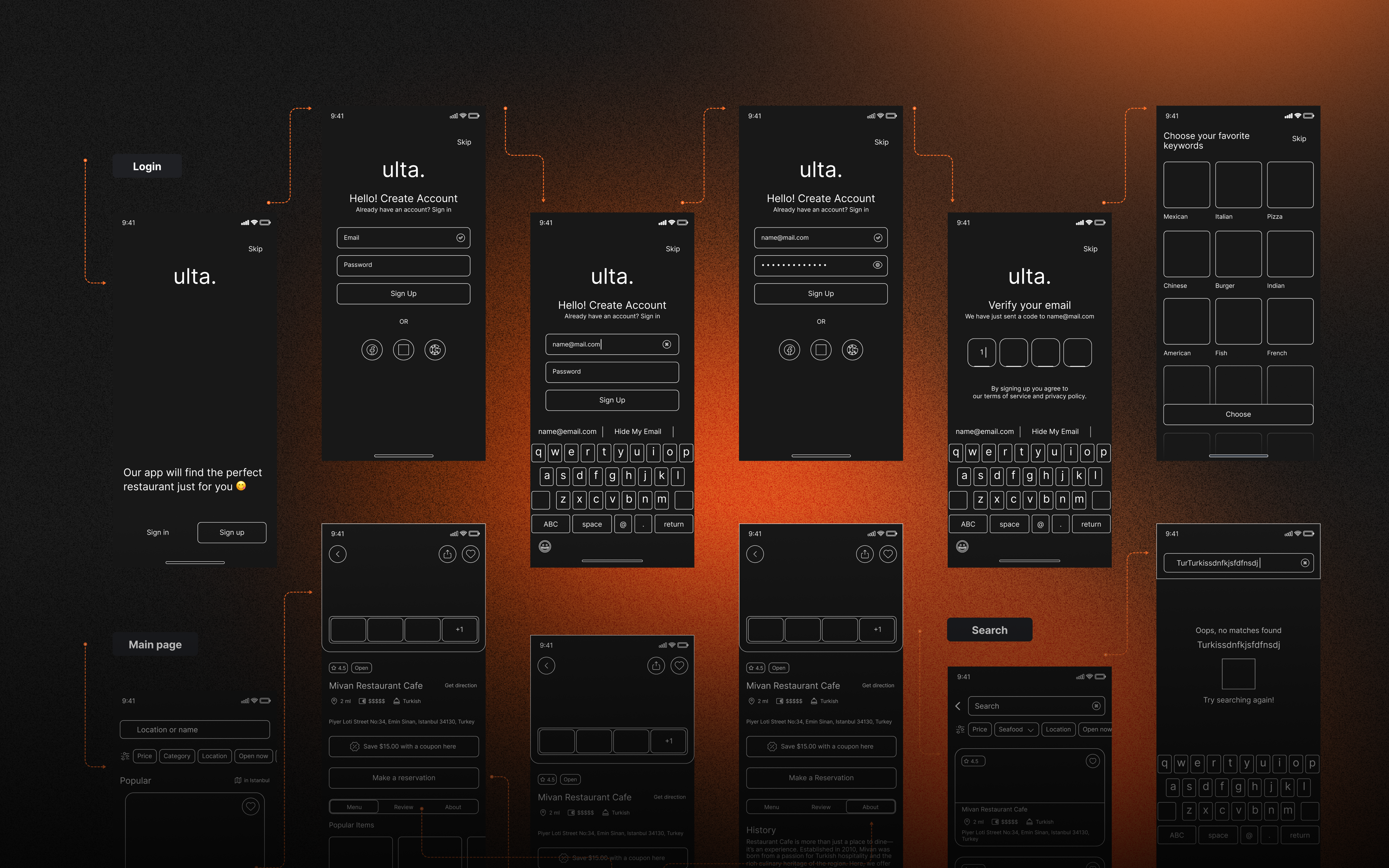
Final Look: Login Interface
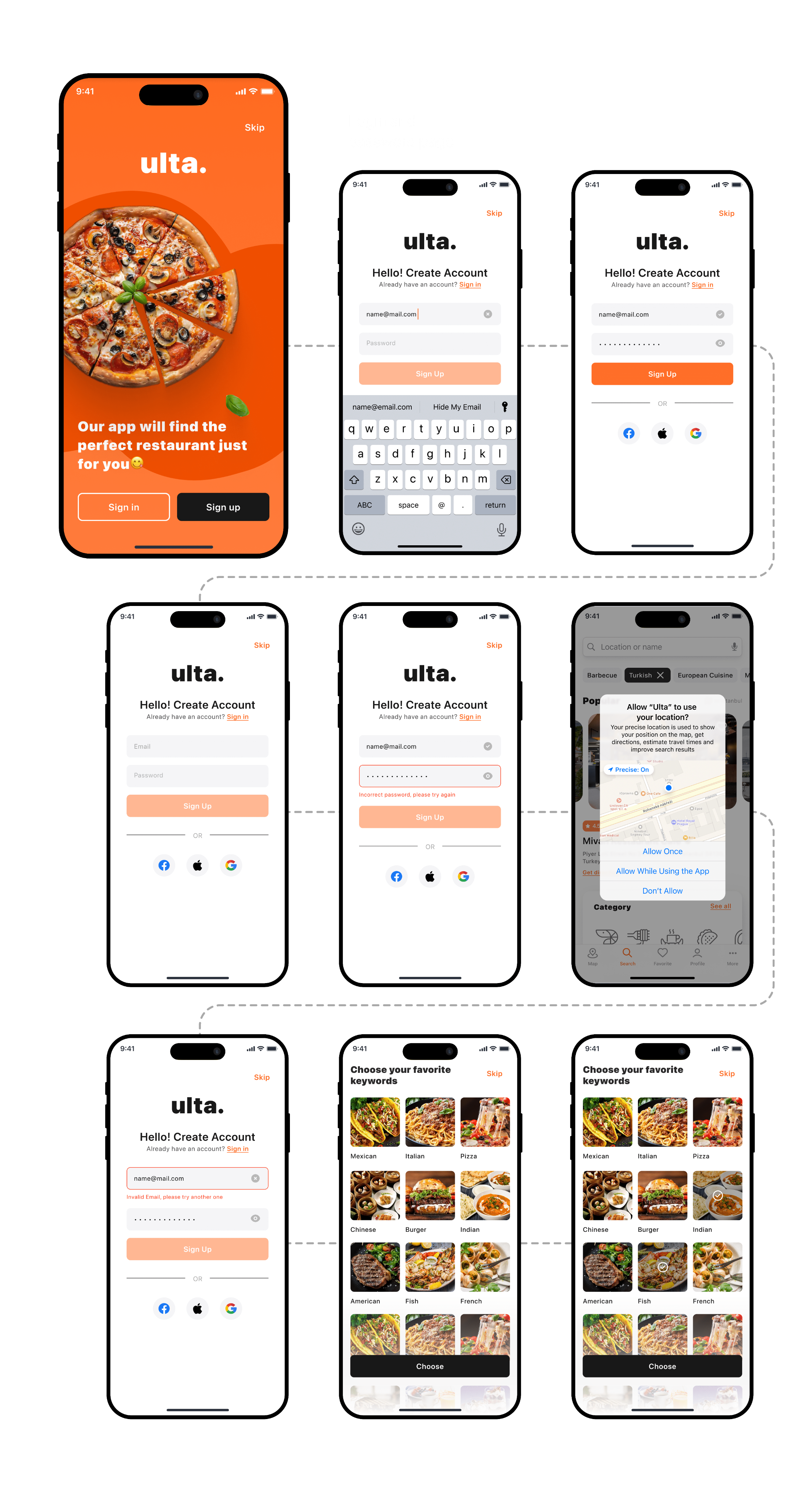
Main page
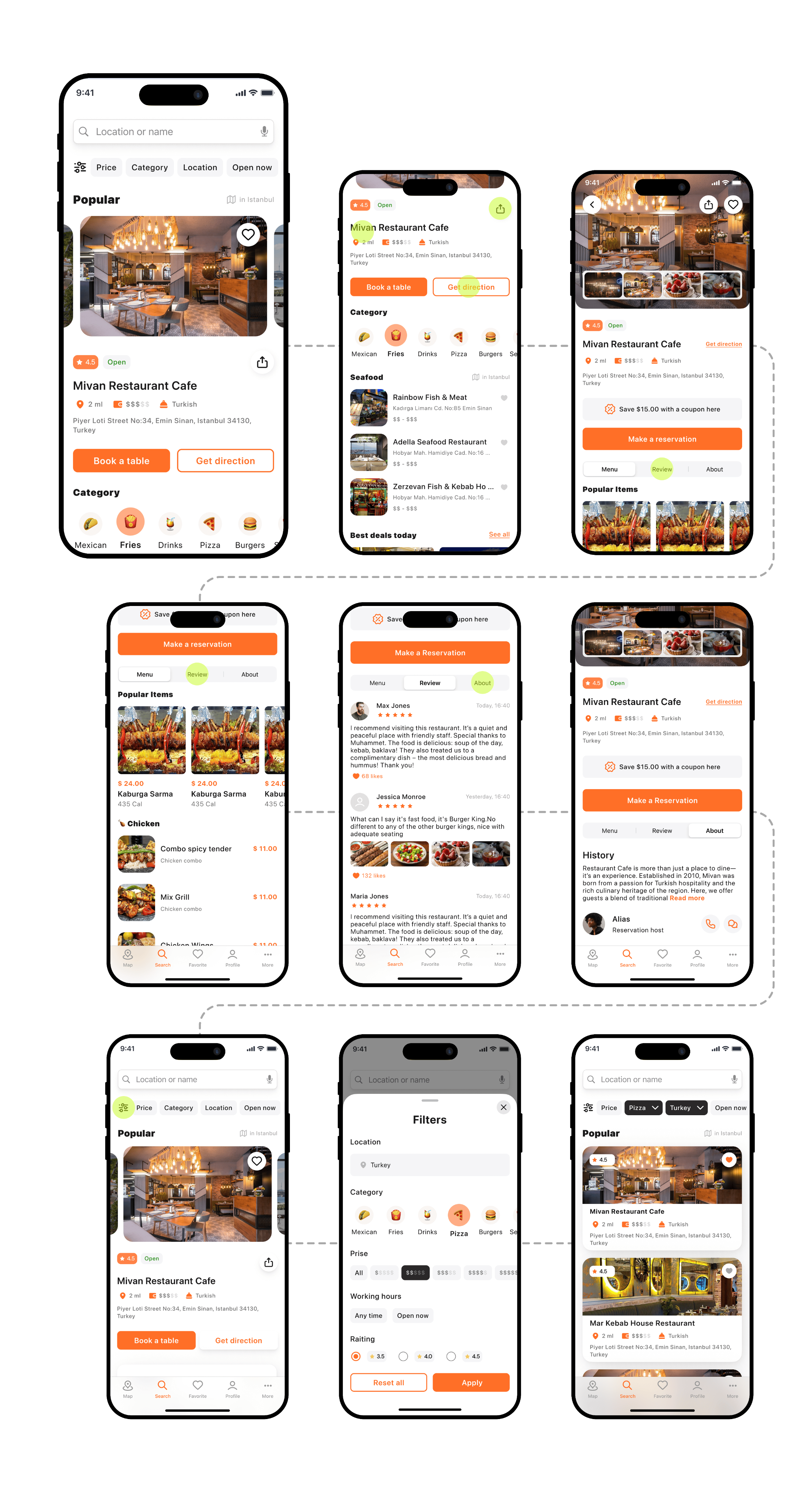
Search
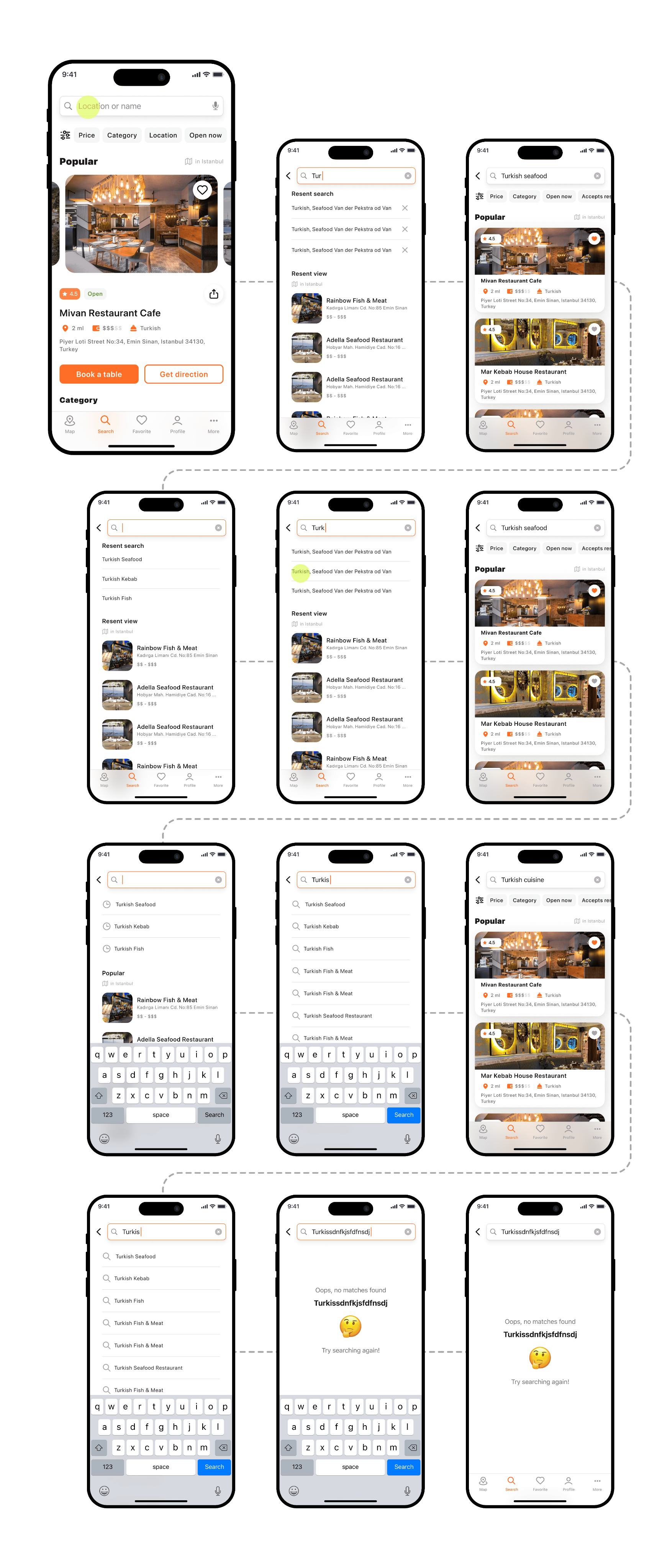
Profile
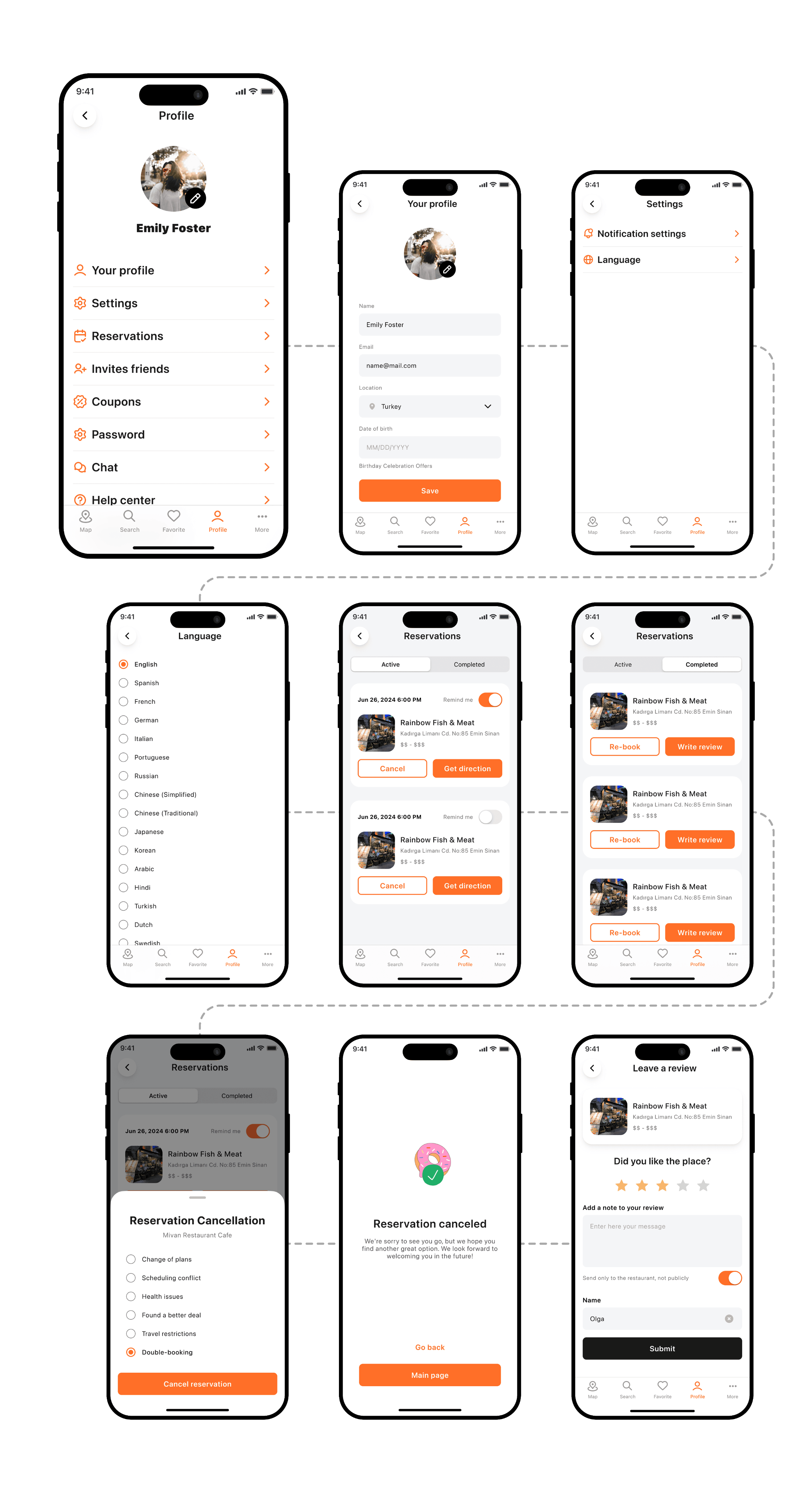
Chat

Voice assistant
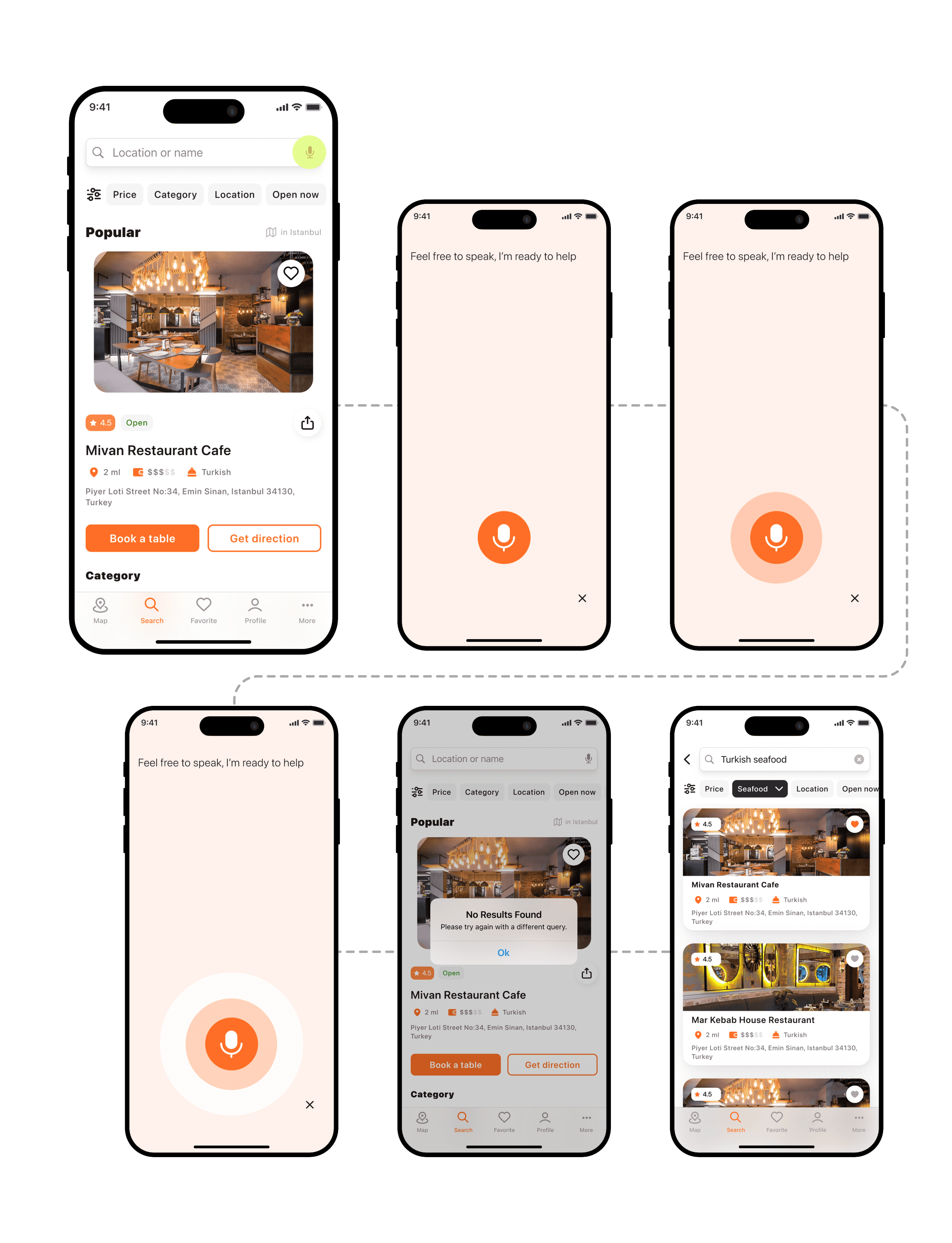
All additional screens
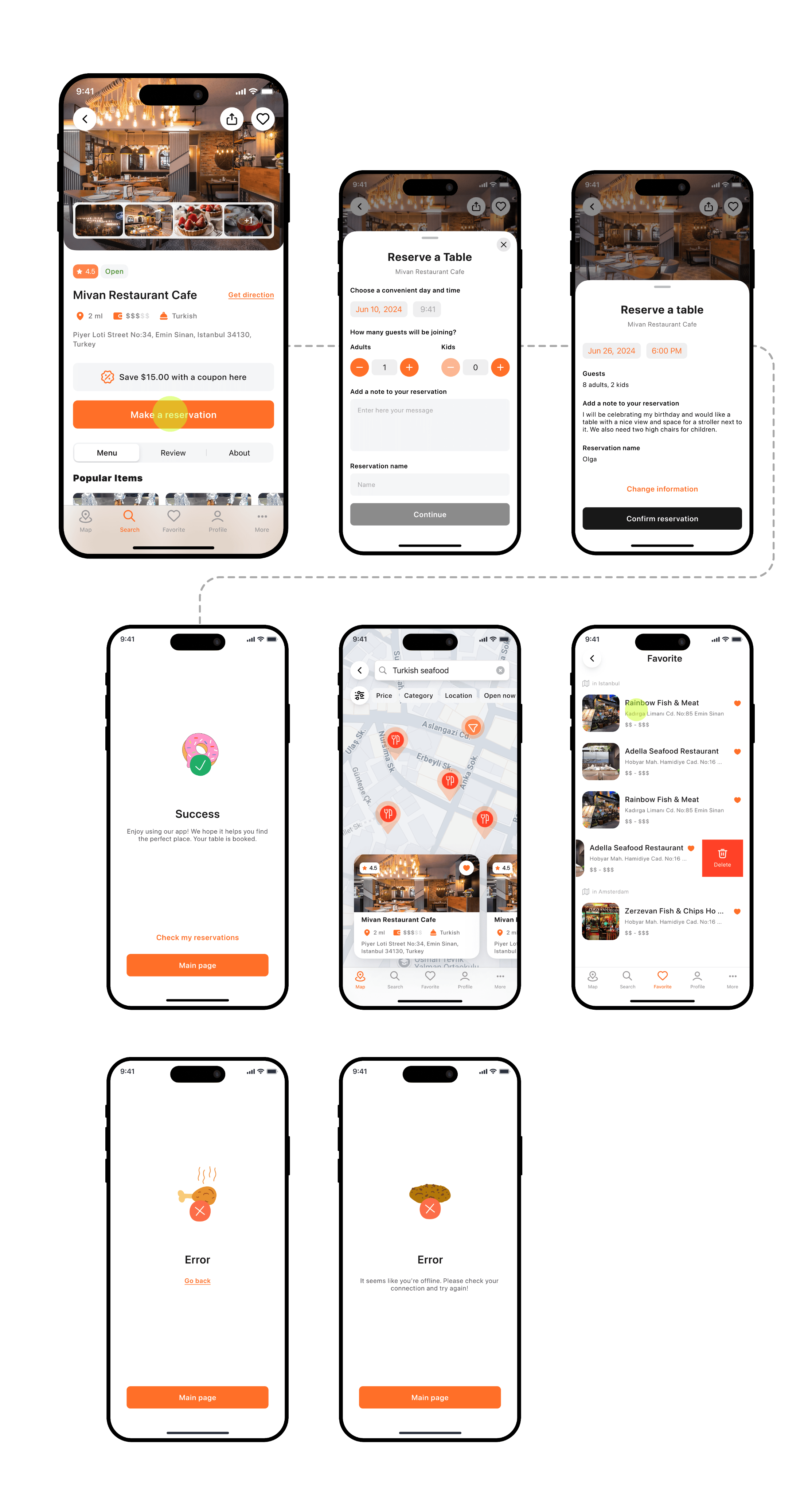
Style Guide
In the styles and UI kit, I created a small number of elements to systematize my work.

This app solves several key problems for modern diners:
🧭 Reliable Discovery in New Cities
Helps travelers find trustworthy restaurants when exploring unfamiliar locations — solving the stress of not knowing where to go.
🧹 Filtered, Not Overwhelming
Instead of flooding users with every option, the app curates quality places, avoiding noisy and unreliable review clutter.
🧠 AI-Powered Personalization
Smart recommendations based on unique preferences like lighting, vibe, or noise level — no more generic “best of” lists.
⚡ Fast, Targeted Filtering
Instantly find what you need: vegan spots, remote-friendly cafes, or hidden coffee gems — all just a tap away.
🗨️ Helpful Support, Wherever You Are
Accessible chat support via in-app messaging and popular platforms, especially handy for travelers relying on Wi-Fi abroad.
🗣️ Voice Assistant for Accessibility
Designed for users with visual impairments or those who prefer voice interaction — intuitive and inclusive by design.
Key Learnings
I truly enjoyed diving deep into the research process — reading through user comments on competitor apps, discovering bugs, surfacing ideas for improvement, and spotting patterns that sparked new hypotheses. It was especially exciting to test those hypotheses through real user surveys and interviews.
Exploring both Android and iOS design libraries gave me a stronger foundation in platform-specific patterns. I also found it fascinating to study how interfaces are adapted for unusual environments like TVs or airplanes — environments where simplicity, clarity, and focus are critical.
As part of the Mobile and Cross-Platform Application Design program at Yandex, I gained hands-on experience designing for a wide range of screens, use cases, and user needs. The training was intense but incredibly rewarding — it reshaped the way I approach mobile UX and multi-platform thinking.
Olga Kusterer
Main page
→
Resume
→
Restaurant guide app
Mobile and Cross-Platform Application Design.


Mobile and Cross-Platform Application Design. This educational project from Yandex was designed for experienced designers, focusing on the step-by-step creation of an app interface from scratch. Before starting the design process, I conducted extensive research on the topic and the product and carried out in-depth interviews with potential users. I was the top student in the course, and the testing of the prototype received positive feedback. About school.
AI-Powered App to Discover Your Favorite or New Dining Spot!
Project Objective
🧭 Problem
People lack a trustworthy and personalized way to discover restaurants and cafes they’ll truly enjoy—especially when traveling. Existing apps overwhelm users with options that don't reflect their unique tastes. Reviews are often unreliable or AI-generated. Word-of-mouth from friends is limited and time-consuming. Influencer and print guides also lack trust and personalization. Modern diners need a smarter, faster solution.
🚀 Solution
ULTA is a curated restaurant guide designed for modern lifestyles. The app offers fast, intelligent search tailored to real needs—like dog-friendly spots, places to work from, or venues with live music. AI personalization considers ambiance, style, and even noise level. Intuitive filters are crafted with a modern user in mind, making decisions faster and more relevant than ever before.
🎯 Audience & Focus
ULTA is designed for curious urban diners aged 20–40 with above-average income who enjoy spending time in cafes and restaurants. Many live in big cities or travel frequently and need quick access to reliable, personalized options. Initial launch focuses on key cultural hubs: Istanbul, Amsterdam, Tallinn, and Paris—each with a vibrant, dynamic food scene.

Secondary Research
Target Diners Aged 20-40.
Through secondary research, I discovered that although tastes and preferences vary based on several factors, Ulta should be optimized for diners aged 20-40. I also concluded that Ulta should not allow users to register with their phone number. Ulta’s target audience is more likely to travel abroad, implying that they may not have a consistent phone number while using the app. Instead, users should be encouraged to register with an email address. Also, chat support can be implemented via WhatsApp or in-app messaging as these services can be accessed using Wi-Fi. Finally, I acquired data from AppFlow, which allowed me to analyze competitor features, user feedback, and technical issues. This research can be found via this link.
Secondary research helped me formulate key hypotheses before conducting in-depth interviews.
Information about cities in numbers
around 15-20 million restaurants in the world /2020
around 1,500 to 2,000 restaurants and eateries in Amsterdam
Paris is home to approximately 15,000 to 20,000 restaurants
Tallinn is estimated to have around 500 to 700 restaurants
Istanbul typically attracts around 10 to 15 million tourists /2024
Istanbul is estimated to have approximately 25,000 to 30,000 restaurants
Amsterdam typically attracts around 8 to 10 million tourists /2024
Paris typically sees approximately 30 to 35 million tourists /2024
Tallinn attracts approximately 1.5 to 2 million tourists annually /2024
In-Depth Interviews
Women
31-64 YEARS OLD

Men
33-64 YEARS OLD

Task
Ask how respondents search for leisure activities or events and identify key features or functions of the app that they use every time.
SAMPLE
User Flow:6 respondents (4 women and 2 men) with an even age distribution (31-62 years old). For the educational project, 6 respondents were sufficient. All of them actively use apps to find and plan leisure activities or enjoy dining at restaurants. They are potential users.
Method
Personal interaction. I asked which apps people use, what their favorite features in apps are, and what is important for them to see or what influences their choice of a particular place.
Summary of Hypotheses
Hypothesis 1
It’s possible to develop a system that recommends new dishes based on a user's favorite meals. The application could generate a personalized list of similar dishes and suggest the best restaurants where these dishes are served.

Hypothesis 2
The possibility to pay with a card for a meal directly through the app while at the restaurant.

Hypothesis 3
Place an order via phone. The ability to make modifications to the dishes in the order, such as removing onions or sour cream from a dish.

Hypothesis 4
Incorporate some form of entertainment into the app while waiting for the waiter or food, such as games, articles, or an educational blog.

Hypothesis 5
The user might prefer looking at photos of dishes rather than text menus and descriptions.

Hypothesis 6
we could attract more users by consolidating ratings from all sources in the restaurant’s profile, including Google, TripAdvisor, Foursquare, and others.

Hypothesis 7
When integrating with other apps, consider supporting various types of maps, such as Waze, Google Maps, and Apple Maps.

Hypothesis 8
Make filters visible at the top and easily collapsible. Allow users to remove specific filters (e.g., cuisine type) without leaving the results page.

Hypothesis 9
Help users make a better choice using navigational icons in the restaurant’s profile. For example, indicate the price range with an icon, show the type of cuisine, or highlight other significant factors.

Hypothesis 10
If payment is made in cash, a prompt should immediately appear for entering the amount of change required.

Hypothesis 11
Personalized builder for wraps, pizzas, and rolls.

Hypothesis 12
Bright labels for dishes. Bright labels make dishes stand out, helping users quickly identify and distinguish between different options.

Hypothesis 13
Additional integrations in the app could help attract more users, such as table reservation, pre-ordering food, or customizing dishes through the app.

Hypothesis 14
Are there difficulties with switching languages, or are there none at all? Alternatively, how challenging is it for a tourist to register using their phone number in another country?

not confirmed
partially confirmed
confirmed
new future
Each hypothesis is accompanied by user avatars, indicating who participated in either testing or validation. This helps ensure the quality of research findings.
User Flow - Main scenario

🌍 Seamless International Access
Email-based login ensures users maintain consistent access to their account while moving between countries.
🍽️ Designed for Real Travel Needs
This decision supports the app’s core goal — helping users find great places to eat while traveling, without connection barriers.
💬 Reliable Support Anywhere
Support is available via WhatsApp and in-app messaging, even without a local phone number.
Wireframe

Final Look: Login Interface

Main page

Search

Profile

Chat

Voice assistant

All additional screens

Style Guide
In the styles and UI kit, I created a small number of elements to systematize my work.

This app solves several key problems for modern diners:
🧭 Reliable Discovery in New Cities
Helps travelers find trustworthy restaurants when exploring unfamiliar locations — solving the stress of not knowing where to go.
🧹 Filtered, Not Overwhelming
Instead of flooding users with every option, the app curates quality places, avoiding noisy and unreliable review clutter.
🧠 AI-Powered Personalization
Smart recommendations based on unique preferences like lighting, vibe, or noise level — no more generic “best of” lists.
⚡ Fast, Targeted Filtering
Instantly find what you need: vegan spots, remote-friendly cafes, or hidden coffee gems — all just a tap away.
🗨️ Helpful Support, Wherever You Are
Accessible chat support via in-app messaging and popular platforms, especially handy for travelers relying on Wi-Fi abroad.
🗣️ Voice Assistant for Accessibility
Designed for users with visual impairments or those who prefer voice interaction — intuitive and inclusive by design.
Key Learnings
I truly enjoyed diving deep into the research process — reading through user comments on competitor apps, discovering bugs, surfacing ideas for improvement, and spotting patterns that sparked new hypotheses. It was especially exciting to test those hypotheses through real user surveys and interviews.
Exploring both Android and iOS design libraries gave me a stronger foundation in platform-specific patterns. I also found it fascinating to study how interfaces are adapted for unusual environments like TVs or airplanes — environments where simplicity, clarity, and focus are critical.
As part of the Mobile and Cross-Platform Application Design program at Yandex, I gained hands-on experience designing for a wide range of screens, use cases, and user needs. The training was intense but incredibly rewarding — it reshaped the way I approach mobile UX and multi-platform thinking.
Olga Kusterer
Main page
→
Resume
→
Restaurant guide app
Mobile and Cross-Platform Application Design.


Mobile and Cross-Platform Application Design. This educational project from Yandex was designed for experienced designers, focusing on the step-by-step creation of an app interface from scratch. Before starting the design process, I conducted extensive research on the topic and the product and carried out in-depth interviews with potential users. I was the top student in the course, and the testing of the prototype received positive feedback. About school.
AI-Powered App to Discover Your Favorite or New Dining Spot!
Project Objective
🧭 Problem
People lack a trustworthy and personalized way to discover restaurants and cafes they’ll truly enjoy—especially when traveling. Existing apps overwhelm users with options that don't reflect their unique tastes. Reviews are often unreliable or AI-generated. Word-of-mouth from friends is limited and time-consuming. Influencer and print guides also lack trust and personalization. Modern diners need a smarter, faster solution.
🚀 Solution
ULTA is a curated restaurant guide designed for modern lifestyles. The app offers fast, intelligent search tailored to real needs—like dog-friendly spots, places to work from, or venues with live music. AI personalization considers ambiance, style, and even noise level. Intuitive filters are crafted with a modern user in mind, making decisions faster and more relevant than ever before.
🎯 Audience & Focus
ULTA is designed for curious urban diners aged 20–40 with above-average income who enjoy spending time in cafes and restaurants. Many live in big cities or travel frequently and need quick access to reliable, personalized options. Initial launch focuses on key cultural hubs: Istanbul, Amsterdam, Tallinn, and Paris—each with a vibrant, dynamic food scene.

Secondary Research
Target Diners Aged 20-40.
Through secondary research, I discovered that although tastes and preferences vary based on several factors, Ulta should be optimized for diners aged 20-40. I also concluded that Ulta should not allow users to register with their phone number. Ulta’s target audience is more likely to travel abroad, implying that they may not have a consistent phone number while using the app. Instead, users should be encouraged to register with an email address. Also, chat support can be implemented via WhatsApp or in-app messaging as these services can be accessed using Wi-Fi. Finally, I acquired data from AppFlow, which allowed me to analyze competitor features, user feedback, and technical issues. This research can be found via this link.
Secondary research helped me formulate key hypotheses before conducting in-depth interviews.
Information about cities in numbers
around 15-20 million restaurants in the world /2020
around 1,500 to 2,000 restaurants and eateries in Amsterdam
Paris is home to approximately 15,000 to 20,000 restaurants
Tallinn is estimated to have around 500 to 700 restaurants
Istanbul typically attracts around 10 to 15 million tourists /2024
Istanbul is estimated to have approximately 25,000 to 30,000 restaurants
Amsterdam typically attracts around 8 to 10 million tourists /2024
Paris typically sees approximately 30 to 35 million tourists /2024
Tallinn attracts approximately 1.5 to 2 million tourists annually /2024
In-Depth Interviews
Women
31-64 YEARS OLD

Men
33-64 YEARS OLD

Task
Ask how respondents search for leisure activities or events and identify key features or functions of the app that they use every time.
SAMPLE
User Flow:6 respondents (4 women and 2 men) with an even age distribution (31-62 years old). For the educational project, 6 respondents were sufficient. All of them actively use apps to find and plan leisure activities or enjoy dining at restaurants. They are potential users.
Method
Personal interaction. I asked which apps people use, what their favorite features in apps are, and what is important for them to see or what influences their choice of a particular place.
Summary of Hypotheses
Hypothesis 1
It’s possible to develop a system that recommends new dishes based on a user's favorite meals. The application could generate a personalized list of similar dishes and suggest the best restaurants where these dishes are served.

Hypothesis 2
The possibility to pay with a card for a meal directly through the app while at the restaurant.

Hypothesis 3
Place an order via phone. The ability to make modifications to the dishes in the order, such as removing onions or sour cream from a dish.

Hypothesis 4
Incorporate some form of entertainment into the app while waiting for the waiter or food, such as games, articles, or an educational blog.

Hypothesis 5
The user might prefer looking at photos of dishes rather than text menus and descriptions.

Hypothesis 6
we could attract more users by consolidating ratings from all sources in the restaurant’s profile, including Google, TripAdvisor, Foursquare, and others.

Hypothesis 7
When integrating with other apps, consider supporting various types of maps, such as Waze, Google Maps, and Apple Maps.

Hypothesis 8
Make filters visible at the top and easily collapsible. Allow users to remove specific filters (e.g., cuisine type) without leaving the results page.

Hypothesis 9
Help users make a better choice using navigational icons in the restaurant’s profile. For example, indicate the price range with an icon, show the type of cuisine, or highlight other significant factors.

Hypothesis 10
If payment is made in cash, a prompt should immediately appear for entering the amount of change required.

Hypothesis 11
Personalized builder for wraps, pizzas, and rolls.

Hypothesis 12
Bright labels for dishes. Bright labels make dishes stand out, helping users quickly identify and distinguish between different options.

Hypothesis 13
Additional integrations in the app could help attract more users, such as table reservation, pre-ordering food, or customizing dishes through the app.

Hypothesis 14
Are there difficulties with switching languages, or are there none at all? Alternatively, how challenging is it for a tourist to register using their phone number in another country?

not confirmed
partially confirmed
confirmed
new future
Each hypothesis is accompanied by user avatars, indicating who participated in either testing or validation. This helps ensure the quality of research findings.
User Flow - Main scenario

🌍 Seamless International Access
Email-based login ensures users maintain consistent access to their account while moving between countries.
🍽️ Designed for Real Travel Needs
This decision supports the app’s core goal — helping users find great places to eat while traveling, without connection barriers.
💬 Reliable Support Anywhere
Support is available via WhatsApp and in-app messaging, even without a local phone number.
Wireframe

Final Look: Login Interface

Main page

Search

Profile

Chat

Voice assistant

All additional screens

Style Guide
In the styles and UI kit, I created a small number of elements to systematize my work.

This app solves several key problems for modern diners:
🧭 Reliable Discovery in New Cities
Helps travelers find trustworthy restaurants when exploring unfamiliar locations — solving the stress of not knowing where to go.
🧹 Filtered, Not Overwhelming
Instead of flooding users with every option, the app curates quality places, avoiding noisy and unreliable review clutter.
🧠 AI-Powered Personalization
Smart recommendations based on unique preferences like lighting, vibe, or noise level — no more generic “best of” lists.
⚡ Fast, Targeted Filtering
Instantly find what you need: vegan spots, remote-friendly cafes, or hidden coffee gems — all just a tap away.
🗨️ Helpful Support, Wherever You Are
Accessible chat support via in-app messaging and popular platforms, especially handy for travelers relying on Wi-Fi abroad.
🗣️ Voice Assistant for Accessibility
Designed for users with visual impairments or those who prefer voice interaction — intuitive and inclusive by design.
Key Learnings
I truly enjoyed diving deep into the research process — reading through user comments on competitor apps, discovering bugs, surfacing ideas for improvement, and spotting patterns that sparked new hypotheses. It was especially exciting to test those hypotheses through real user surveys and interviews.
Exploring both Android and iOS design libraries gave me a stronger foundation in platform-specific patterns. I also found it fascinating to study how interfaces are adapted for unusual environments like TVs or airplanes — environments where simplicity, clarity, and focus are critical.
As part of the Mobile and Cross-Platform Application Design program at Yandex, I gained hands-on experience designing for a wide range of screens, use cases, and user needs. The training was intense but incredibly rewarding — it reshaped the way I approach mobile UX and multi-platform thinking.
